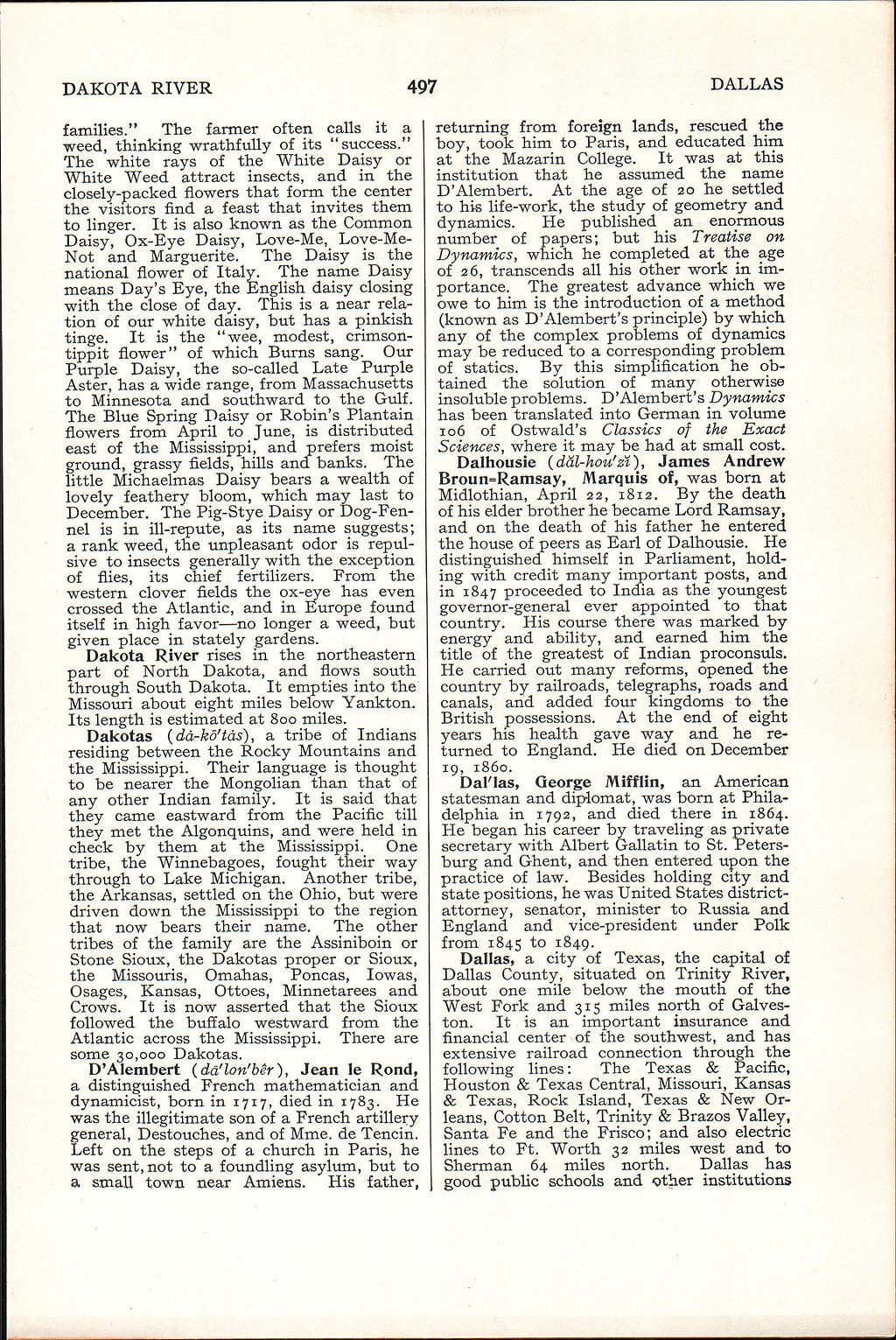families.” The farmer often calls it a weed, thinking wrathfully of its “success.” The white rays of the White Daisy or White Weed attract insects, and in the closely-packed flowers that form the center the visitors find a feast that invites them to linger. It is also known as the Common Daisy, Ox-Eye Daisy, Love-Me, Love-Me-Not and Marguerite. The Daisy is the national flower of Italy. The name Daisy means Day's Eye, the English daisy closing with the close of day. This is a near relation of our white daisy, but has a pinkish tinge. It is the “wee, modest, crimson-tippit flower” of which Burns sang. Our Purple Daisy, the so-called Late Purple Aster, has a wide range, from Massachusetts to Minnesota and southward to the Gulf. The Blue Spring Daisy or Robin's Plantain flowers from April to June, is distributed east of the Mississippi, and prefers moist ground, grassy fields, hills and banks. The little Michaelmas Daisy bears a wealth of lovely feathery bloom, which may last to December. The Pig-Stye Daisy or Dog-Fennel is in ill-repute, as its name suggests; a rank weed, the unpleasant odor is repulsive to insects generally with the exception of flies, its chief fertilizers. From the western clover fields the ox-eye has even crossed the Atlantic, and in Europe found itself in high favor—no longer a weed, but given place in stately gardens.
Dakota River rises in the northeastern part of North Dakota, and flows south through South Dakota. It empties into the Missouri about eight miles below Yankton. Its length is estimated at 800 miles.
Dakotas (dȧ-kō′tȧs), a tribe of Indians residing between the Rocky Mountains and the Mississippi. Their language is thought to be nearer the Mongolian than that of any other Indian family. It is said that they came eastward from the Pacific till they met the Algonquins, and were held in check by them at the Mississippi. One tribe, the Winnebagoes, fought their way through to Lake Michigan. Another tribe, the Arkansas, settled on the Ohio, but were driven down the Mississippi to the region that now bears their name. The other tribes of the family are the Assiniboin or Stone Sioux, the Dakotas proper or Sioux, the Missouris, Omahas, Poncas, Iowas, Osages, Kansas, Ottoes, Minnetarees and Crows. It is now asserted that the Sioux followed the buffalo westward from the Atlantic across the Mississippi. There are some 30,000 Dakotas.
D'Alembert (dä′lon′bêr), Jean le Rond, a distinguished French mathematician and dynamicist, born in 1717, died in 1783. He was the illegitimate son of a French artillery general, Destouches, and of Mme. de Tencin. Left on the steps of a church in Paris, he was sent, not to a foundling asylum, but to a small town near Amiens. His father, returning from foreign lands, rescued the boy, took him to Paris, and educated him at the Mazarin College. It was at this institution that he assumed the name D'Alembert. At the age of 20 he settled to his life-work, the study of geometry and dynamics. He published an enormous number of papers; but his Treatise on Dynamics, which he completed at the age of 26, transcends all his other work in importance. The greatest advance which we owe to him is the introduction of a method (known as D'Alembert's principle) by which any of the complex problems of dynamics may be reduced to a corresponding problem of statics. By this simplification he obtained the solution of many otherwise insoluble problems. D'Alembert's Dynamics has been translated into German in volume 106 of Ostwald's Classics of the Exact Sciences, where it may be had at small cost.
Dalhousie (dăl-hou′zĭ), James Andrew Broun-Ramsay, Marquis of, was born at Midlothian, April 22, 1812. By the death of his elder brother he became Lord Ramsay, and on the death of his father he entered the house of peers as Earl of Dalhousie. He distinguished himself in Parliament, holding with credit many important posts, and in 1847 proceeded to India as the youngest governor-general ever appointed to that country. His course there was marked by energy and ability, and earned him the title of the greatest of Indian proconsuls. He carried out many reforms, opened the country by railroads, telegraphs, roads and canals, and added four kingdoms to the British possessions. At the end of eight years his health gave way and he returned to England. He died on December 19, 1860.
Dal′las, George Mifflin, an American statesman and diplomat, was born at Philadelphia in 1792, and died there in 1864. He began his career by traveling as private secretary with Albert Gallatin to St. Petersburg and Ghent, and then entered upon the practice of law. Besides holding city and state positions, he was United States district-attorney, senator, minister to Russia and England and vice-president under Polk from 1845 to 1849.
Dallas, a city of Texas, the capital of Dallas County, situated on Trinity River, about one mile below the mouth of the West Fork and 315 miles north of Galveston. It is an important insurance and financial center of the southwest, and has extensive railroad connection through the following lines: The Texas & Pacific, Houston & Texas Central, Missouri, Kansas & Texas, Rock Island, Texas & New Orleans, Cotton Belt, Trinity & Brazos Valley, Santa Fe and the Frisco; and also electric lines to Ft. Worth 32 miles west and to Sherman 64 miles north. Dallas has good public schools and other institutions
